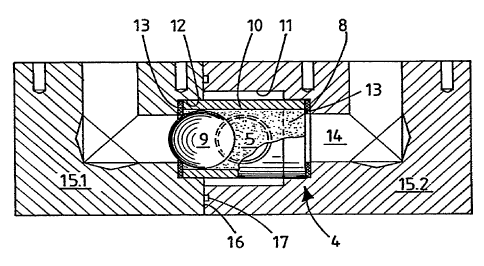Some of the information on this Web page has been provided by external sources. The Government of Canada is not responsible for the accuracy, reliability or currency of the information supplied by external sources. Users wishing to rely upon this information should consult directly with the source of the information. Content provided by external sources is not subject to official languages, privacy and accessibility requirements.
Any discrepancies in the text and image of the Claims and Abstract are due to differing posting times. Text of the Claims and Abstract are posted:
| (12) Patent: | (11) CA 2221272 |
|---|---|
| (54) English Title: | A TWIN FILTER FOR COMPRESSED AIR |
| (54) French Title: | FILTRE DOUBLE POUR L'AIR COMPRIME |
| Status: | Deemed expired |
| (51) International Patent Classification (IPC): |
|
|---|---|
| (72) Inventors : |
|
| (73) Owners : |
|
| (71) Applicants : |
|
| (74) Agent: | GOWLING WLG (CANADA) LLP |
| (74) Associate agent: | |
| (45) Issued: | 2006-07-25 |
| (86) PCT Filing Date: | 1996-05-28 |
| (87) Open to Public Inspection: | 1996-12-12 |
| Examination requested: | 2003-05-20 |
| Availability of licence: | N/A |
| (25) Language of filing: | English |
| Patent Cooperation Treaty (PCT): | Yes |
|---|---|
| (86) PCT Filing Number: | PCT/FI1996/000300 |
| (87) International Publication Number: | WO1996/039240 |
| (85) National Entry: | 1997-11-14 |
| (30) Application Priority Data: | ||||||
|---|---|---|---|---|---|---|
|
The object of the invention is a twin filter for compressed air, in which
there are two filters (3) set in parallel and an arrangement
of valves (2, 4) to direct compressed air through a selected filter (3), which
arrangement of valves includes inlet valves (2) to distribute
compressed air from the inlet (1) to the selected filter (3) and an
arrangement of counter-valves (4) to direct the compressed air from the
selected filter to the compressed air outlet (5.1). The arrangement of counter-
valves includes a ball chamber (8) formed in the housing
structure, at the ends of which are inlet connections (14) and an outlet
connection (5) in the centre. A ball (9) is arranged to close that inlet
connection (14) in which there is no pressure. The ball chamber consists of a
filter element (10) that is, as such, known, in the central area
of which a ring-like outlet channel (11) is formed, which collects the outlet
flow to the outlet connection (5).
L'invention porte sur un filtre double pour l'air comprimé, dans lequel il y a deux filtres (3) placés en parallèle et un système de valves (2, 4) pour diriger l'air comprimé vers un filtre choisi (3). Ce système de valves comprend des valves d'entrée (2) pour diriger l'air comprimé depuis l'entrée (1) vers le filtre choisi (3) et un système de contre-valves (4) pour diriger l'air comprimé du filtre choisi vers la sortie d'air comprimé choisie (5.1). Le système de contre-valves comprend une chambre (8) à bille formée dans la structure du logement, avec des conduits d'entrée (14) aux extrémités et un conduit de sortie (5) au centre. Une bille (9) est prévue pour fermer le conduit d'entrée (14) sur lequel il n'y a pas de pression. La chambre à bille comprend un élément filtrant (10) d'un type connu et dans la zone centrale duquel se trouve un canal de sortie (annulaire) qui reçoit le flux de sortie allant vers le conduit de sortie (5).
Note: Claims are shown in the official language in which they were submitted.
Note: Descriptions are shown in the official language in which they were submitted.

For a clearer understanding of the status of the application/patent presented on this page, the site Disclaimer , as well as the definitions for Patent , Administrative Status , Maintenance Fee and Payment History should be consulted.
| Title | Date |
|---|---|
| Forecasted Issue Date | 2006-07-25 |
| (86) PCT Filing Date | 1996-05-28 |
| (87) PCT Publication Date | 1996-12-12 |
| (85) National Entry | 1997-11-14 |
| Examination Requested | 2003-05-20 |
| (45) Issued | 2006-07-25 |
| Deemed Expired | 2011-05-30 |
There is no abandonment history.
Note: Records showing the ownership history in alphabetical order.
| Current Owners on Record |
|---|
| JAUHOLA, LAURI |
| Past Owners on Record |
|---|
| NIKKILA, TERO |